June 24, 2025 | New Article in The International Journal of High Performance Computing Applications
This work introduces a machine learning framework trained on CFD-simulated bifurcation lesions to non-invasively predict iFR and FFR using only anatomical features. It demonstrates how digital twins, combined with statistical modeling, can support functional decision-making in complex coronary interventions. The study builds on our lab’s work in digital twin modeling and extends it into one of the most challenging domains in interventional cardiology: coronary bifurcations.

We are excited to share the publication of our latest work: “Simulation-based machine learning for real-time assessment of side-branch hemodynamics in coronary bifurcation lesions.” This project, led by former Randles Lab postdoc Dr. Arash Ghorbannia, presents a new ML-based framework to predict functional metrics like iFR and FFR from pre-operative anatomical data alone—without the need for invasive pressure wires.
Coronary bifurcation lesions are particularly difficult to assess due to complex flow patterns and procedural uncertainty when treating the side branch. In this study, the team created a synthetic dataset of 252 bifurcation lesions simulated using HARVEY, our massively parallel CFD solver. They used linear mixed-effects models to incorporate patient-specific anatomical variability and trained machine learning models to predict iFR (resting) and FFR (hyperemic) outcomes.
Two clinically motivated data-splitting strategies were tested: one reflecting “new anatomy” conditions and another simulating real-world clinical planning with matched preoperative anatomy. The framework achieved strong performance, with AUCs of 0.899 (FFR) and 0.874 (iFR) in the matched scenario.
This work offers a promising tool for non-invasive, personalized planning of bifurcation interventions and highlights how machine learning, when grounded in physics-based modeling, can enhance clinical decision-making in complex cardiovascular cases.
📄 Read the full paper: https://duke.is/mlbifurcation25
Ghorbannia, A., Tanade, C., Yousef, A., Khan, N.S., Vardhan, M., Chi, J., Roychowdhury, S., Das, A., Leopold, J.A., Chi, E., & Randles, A. Simulation-based machine learning for real-time assessment of side-branch hemodynamics in coronary bifurcation lesions. The International Journal of High Performance Computing Applications, 2025.